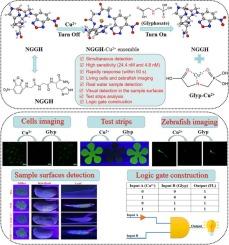一种新型荧光“开关-开关”肽基探针,用于高选择性和连续检测Cu2+和草甘膦及其多功能应用
IF 4.6
2区 化学
Q1 SPECTROSCOPY
Spectrochimica Acta Part A: Molecular and Biomolecular Spectroscopy
Pub Date : 2025-09-13
DOI:10.1016/j.saa.2025.126942
引用次数: 0
摘要
铜离子(Cu2+)和草甘膦(Glyp)对人类健康和生态环境构成严重威胁,对这些物质进行高效、灵敏的检测具有重要意义。本文建立了一种简单新颖的7-硝基-2,1,3-苯并二唑(NBD)共轭三肽(Gly-Gly-His-NH2)荧光“开-开”肽基探针NGGH,用于100%水溶液中Cu2+和草甘膦的继电检测,Cu2+和草甘膦的检出限(lod)分别达到24.4 nM和4.8 nM。通过Job’s plot curve、荧光滴定、ESI-HRMS和理论计算,证明NGGH与Cu2+的结合化学计量为1:1。值得注意的是,Cu2+和草甘膦的荧光成像显示,基于显著的荧光行为和低细胞毒性,NGGH成功应用于活细胞和斑马鱼幼虫。此外,NGGH不仅成功测定了两个实际样品中的Cu2+和草甘膦,还应用于谷子、猕猴桃和叶片表面Cu2+和草甘膦残留的监测。将NGGH制成荧光试纸条,在365 nm紫外灯下肉眼检测Cu2+和草甘膦。最后,基于荧光“开-关-开”的响应效应特性,构建了灵敏的抑制逻辑门。本文章由计算机程序翻译,如有差异,请以英文原文为准。

A novel fluorescence “on-off-on” peptidyl probe for highly selective and consecutive detection of Cu2+ and glyphosate and its multi-functional applications
Copper ions (Cu2+) and glyphosate (Glyp) pose serious threats to human health and the ecological environment, and it is of great significance to conduct efficient and sensitive detection of these substances. Herein, a simple and novel fluorescence “on-off-on” peptidyl probe NGGH with 7-Nitro-2,1,3-benzoxadiazole (NBD) conjugated tripeptide (Gly-Gly-His-NH2) was developed for relay detection of Cu2+ and glyphosate in 100 % aqueous solutions, and the limit of detections (LODs) reached up to 24.4 nM and 4.8 nM for Cu2+ and glyphosate, respectively. The binding stoichiometry of NGGH with Cu2+ was proved to be 1:1 based on Job's plot curve, fluorescence titration, ESI-HRMS and theoretical calculations. Notably, fluorescence imaging of Cu2+ and glyphosate revealed that NGGH was successfully applied on living cells and zebrafish larvae based on remarkable fluorescence behavior and low cytotoxicity. In addition, NGGH not only successfully determined Cu2+ and glyphosate in two real samples, but also applied to monitor the residues of Cu2+ and glyphosate in the surfaces of millet, kiwifruit and leaf. Furthermore, NGGH was fabricated into the fluorescence test strips and used for the visual detection of Cu2+ and glyphosate using naked eye under the 365 nm UV lamp. Finally, we constructed the sensitive INHIBIT logic gate based on the fluorescence “on-off-on” response effect characteristic.
求助全文
通过发布文献求助,成功后即可免费获取论文全文。
去求助
来源期刊
CiteScore
8.40
自引率
11.40%
发文量
1364
审稿时长
40 days
期刊介绍:
Spectrochimica Acta, Part A: Molecular and Biomolecular Spectroscopy (SAA) is an interdisciplinary journal which spans from basic to applied aspects of optical spectroscopy in chemistry, medicine, biology, and materials science.
The journal publishes original scientific papers that feature high-quality spectroscopic data and analysis. From the broad range of optical spectroscopies, the emphasis is on electronic, vibrational or rotational spectra of molecules, rather than on spectroscopy based on magnetic moments.
Criteria for publication in SAA are novelty, uniqueness, and outstanding quality. Routine applications of spectroscopic techniques and computational methods are not appropriate.
Topics of particular interest of Spectrochimica Acta Part A include, but are not limited to:
Spectroscopy and dynamics of bioanalytical, biomedical, environmental, and atmospheric sciences,
Novel experimental techniques or instrumentation for molecular spectroscopy,
Novel theoretical and computational methods,
Novel applications in photochemistry and photobiology,
Novel interpretational approaches as well as advances in data analysis based on electronic or vibrational spectroscopy.

 求助内容:
求助内容: 应助结果提醒方式:
应助结果提醒方式:


